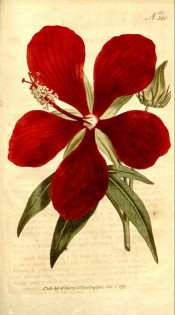Hibiscus moschato-speciosus [Bidwill]
Probably an Abelmoschus moschatus Medik. x Hibiscus coccineus Walter hybrid. I have found no description of this plant but it is reasonable to assume that the hybrid would share the herbaceous habit and bright red flowers of both parents, assuming moschatus to be the subspecies tuberosus. The illustration of Hibiscus coccineus given here is a possible likeness.
Horticultural & Botanical History
Hibiscus moschatus Salisb. is a recognised synonym of Abelmoschus moschatus Medik., as is Hibiscus abelmoschus L. An erect or trailing herb or sub-shrub, depending on the variety, with variable but usually lobed leaves. The subspecies moschatus has single yellow flowers with a dark purple baal spot. Subspecies tuberosus is a trailing plant with red flowers and an underground tuber. The plant dies back to this tuber in the dry season, emerging again with the wet season. [FNSW, internet sources]. A relative of the okra, the tubers have been used as a source of food. A native of South East Asia it has also been recorded from Northern Australia where it may also be native. Hibiscus speciosus Ait. is a synonym of Hibiscus coccineus Walter, a North American species with bright red flowers.
‘Those who “admire Nature’s clocks more than her watches,” will view, we presume, with some pleasure our representation of this very superb species of Hibiscus [Hibiscus speciosus], a native of Carolina, and cultivated here by Dr. John Fothergill, in 1778.
This species is altogether herbaceous, and from a perennial root yearly throws up a stem to the height of many feet, clothed with foliage of a beautiful form and smoothness, and supporting at its summit several flowers, distinguished for their grandeur and richness of colour; these usually blossom in August, and if the plant be kept in the stove, as it most, commonly is, are followed by ripe seeds, by which it is most commonly propagated.
In the Hort. Kew. it is marked as a greenhouse plant; it may no doubt be preserved in the greenhouse; there is even no impediment to its growing in the open border, if placed in a warm and sheltered situation; and the only motive for keeping it in the stove is its being found to flower there more advantageously, and to ripen its seeds with more certainty.’ [BM t.360/1795].
Hibiscus moschatus Roxb. ex Wight & Arn. is a synonym of Hibiscus rugosus Roxb. ex Steud., an Indian species. This may have been the plant used by Bidwill.
History at Camden Park
Hybridised by John Bidwill in Tahiti and seeds were sent to William Macarthur in late 1845 or 1846. Macarthur wrote on 7th August 1846 ‘the Hibiscus moschato-speciosus […] came up well and are doing well.’ [MP A2933-2, p.18].
Notes
Published Jan 11, 2010 - 01:00 PM | Last updated Jan 16, 2010 - 03:33 PM

Hibiscus coccineus Walter | BM t.360/1795 | BHL. Hibiscus moschato-speciosus probably looked much like this.
| Family | Malvaceae |
|---|---|
| Category | |
| Region of origin | Garden origin Tahiti |
| Synonyms | |
| Common Name | |
| Name in the Camden Park Record | Hibiscus moschato-speciosus |
| Confidence level | low |